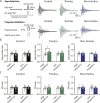Noise-induced plasticity of KCNQ2/3 and HCN channels underlies vulnerability and resilience to tinnitus
- PMID: 26312501
- PMCID: PMC4592936
- DOI: 10.7554/eLife.07242
Noise-induced plasticity of KCNQ2/3 and HCN channels underlies vulnerability and resilience to tinnitus
Abstract
Vulnerability to noise-induced tinnitus is associated with increased spontaneous firing rate in dorsal cochlear nucleus principal neurons, fusiform cells. This hyperactivity is caused, at least in part, by decreased Kv7.2/3 (KCNQ2/3) potassium currents. However, the biophysical mechanisms underlying resilience to tinnitus, which is observed in noise-exposed mice that do not develop tinnitus (non-tinnitus mice), remain unknown. Our results show that noise exposure induces, on average, a reduction in KCNQ2/3 channel activity in fusiform cells in noise-exposed mice by 4 days after exposure. Tinnitus is developed in mice that do not compensate for this reduction within the next 3 days. Resilience to tinnitus is developed in mice that show a re-emergence of KCNQ2/3 channel activity and a reduction in HCN channel activity. Our results highlight KCNQ2/3 and HCN channels as potential targets for designing novel therapeutics that may promote resilience to tinnitus.
Keywords: HCN channels; homeostatic plasticity; hyperexcitability-related disorders; mouse; neuroscience; potassium channels; tinnitus.
Conflict of interest statement
The authors declare that no competing interests exist.
Figures












Similar articles
-
Transient Delivery of a KCNQ2/3-Specific Channel Activator 1 Week After Noise Trauma Mitigates Noise-Induced Tinnitus.J Assoc Res Otolaryngol. 2021 Apr;22(2):127-139. doi: 10.1007/s10162-021-00786-3. Epub 2021 Feb 11. J Assoc Res Otolaryngol. 2021. PMID: 33575914 Free PMC article.
-
Pathogenic plasticity of Kv7.2/3 channel activity is essential for the induction of tinnitus.Proc Natl Acad Sci U S A. 2013 Jun 11;110(24):9980-5. doi: 10.1073/pnas.1302770110. Epub 2013 May 28. Proc Natl Acad Sci U S A. 2013. PMID: 23716673 Free PMC article.
-
Potent KCNQ2/3-specific channel activator suppresses in vivo epileptic activity and prevents the development of tinnitus.J Neurosci. 2015 Jun 10;35(23):8829-42. doi: 10.1523/JNEUROSCI.5176-14.2015. J Neurosci. 2015. PMID: 26063916 Free PMC article.
-
Sodium and potassium channel dysfunctions in rare and common idiopathic epilepsy syndromes.Brain Dev. 2009 Aug;31(7):515-20. doi: 10.1016/j.braindev.2009.04.012. Epub 2009 May 22. Brain Dev. 2009. PMID: 19464834 Review.
-
Neurophysiology of HCN channels: from cellular functions to multiple regulations.Prog Neurobiol. 2014 Jan;112:1-23. doi: 10.1016/j.pneurobio.2013.10.001. Epub 2013 Oct 29. Prog Neurobiol. 2014. PMID: 24184323 Review.
Cited by
-
A Role for KCNQ Channels on Cell Type-Specific Plasticity in Mouse Auditory Cortex after Peripheral Damage.J Neurosci. 2023 Mar 29;43(13):2277-2290. doi: 10.1523/JNEUROSCI.1070-22.2023. Epub 2023 Feb 22. J Neurosci. 2023. PMID: 36813573 Free PMC article.
-
Noise-induced hearing loss enhances Ca2+-dependent spontaneous bursting activity in lateral cochlear efferents.bioRxiv [Preprint]. 2025 Jan 8:2025.01.07.631771. doi: 10.1101/2025.01.07.631771. bioRxiv. 2025. PMID: 39829915 Free PMC article. Preprint.
-
Neuroinflammation mediates noise-induced synaptic imbalance and tinnitus in rodent models.PLoS Biol. 2019 Jun 18;17(6):e3000307. doi: 10.1371/journal.pbio.3000307. eCollection 2019 Jun. PLoS Biol. 2019. PMID: 31211773 Free PMC article.
-
HCN2 channels in the ventral tegmental area regulate behavioral responses to chronic stress.Elife. 2018 Jan 2;7:e32420. doi: 10.7554/eLife.32420. Elife. 2018. PMID: 29256865 Free PMC article.
-
Transient Delivery of a KCNQ2/3-Specific Channel Activator 1 Week After Noise Trauma Mitigates Noise-Induced Tinnitus.J Assoc Res Otolaryngol. 2021 Apr;22(2):127-139. doi: 10.1007/s10162-021-00786-3. Epub 2021 Feb 11. J Assoc Res Otolaryngol. 2021. PMID: 33575914 Free PMC article.
References
Publication types
MeSH terms
Substances
Grants and funding
LinkOut - more resources
Full Text Sources
Other Literature Sources
Medical
Molecular Biology Databases

